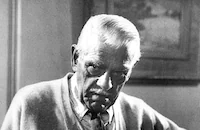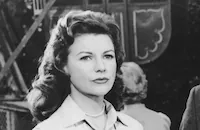Bedlam

Brief Synopsis
Cast & Crew
Mark Robson
Boris Karloff
Anna Lee
Billy House
Richard Fraser
Glenn Vernon
Film Details
Technical Specs

Synopsis
In 1761, while driving through London, Lord Mortimer and his mistress, actress Nell Bowen, are stopped outside St. Mary's of Bethlehem Asylum, a notorious mental institution known as "Bedlam." Earlier, a poet named Colby was shoved from Bedlam's roof while trying to escape, and Lord Mortimer, his patron, is notified of his death. Curious, Lord Mortimer questions Bedlam's head warden, George Sims, about Colby's fall. After insisting that Colby's demise was an accident, the smooth-talking, sadistic Sims convinces Mortimer to use some of Bedlam's inmates to replace the poet as the entertainment at his upcoming banquet. Disgusted by Sim's suggestion that his "Bedlamites" will make a fine amusement, Nell decides to visit the asylum before the fete . Nell is horrified by the suffering and depravation she sees in Bedlam and hits Sims in anger. The blow is witnessed by William Hannah, a Quaker stonemason, whom Sims had previously tried to engage in fraud. Although the peace-loving William applauds Nell for her compassion, the actress coldly insists that she struck Sims out of annoyance, not pity. At the banquet, Sims forces his frightened wards to perform for Mortimer's guests, and one young patient dies as a result of the gilding that Sims has painted on his skin. Once again, Nell's ire is provoked, and she later accepts William's advice to use her influence with Mortimer to improve conditions at Bedlam. Although the slow-witted Mortimer at first agrees to Nell's suggestions, Sims changes his mind by reminding him that the reforms will cost him £500 in taxes. After Nell breaks with Mortimer, he evicts her from her home and confiscates most of her belongings. Nell counters by placing her parrot, who loves to recite an unflattering poem about Mortimer, for sale in a public market. When Nell refuses to sell the parrot to Mortimer for a reasonable sum, he follows Sims's advice to place a writ of seizure against the bird. Backed by William, Nell rejects Mortimer's writ and then goes to see Mortimer's political opponent, "That Devil" John Wilkes, about the situation. Worried about Wilkes's potential involvement, Sims and Mortimer try to bribe Nell, but she laughingly eats their proffered bill. Sims and Mortimer then force Nell to appear before the Commission of Lunacy, of which Mortimer is a member, and she is found insane and thrown into Bedlam. William eventually discovers her whereabouts and sneaks into the asylum to see her. Nell tells William to find Wilkes and begs him to give her his masonry trowel as a means of protection. While William tracks down Wilkes, Nell is befriended by Bedlam's "pillar," a trio of educated inmates. After she is mocked by Sims for associating with Bedlam's "aristocracy," Nell determines to help all of the asylum's afflicted through simple kindnesses. Sims punishes Nell's deeds by throwing her in a cell with a large, violent inmate known as "Tom, the Tiger," but Nell's belief in Tom's goodness saves her from attack. William and Wilkes, meanwhile, arrange a new hearing for Nell. The day before the Commission is to reconsider her case, however, Sims declares that Nell must be given his "cure." Sure that Sims intends to kill Nell, the other inmates attack him, and Nell escapes with Tom's help. Sims is then "tried" by his charges, but is eventually found sane. As he is about to be released, however, a beautiful mute stabs him with Nell's trowel, and the inmates cover the attack by enclosing him in a wall while still alive. William and Nell return to Bedlam with the Commission, and although they both deduce Sims's fate, they choose to remain silent.

Director

Mark Robson
Cast

Boris Karloff

Anna Lee
Billy House
Richard Fraser

Glenn Vernon

Ian Wolfe
Leland Hodgson
Joan Newton

Elizabeth Russell
Victor Holbrook
Robert Clarke
Larry Wheat
Bruce Edwards
John Meredith
John Beck

Ellen Corby
John Ince
Skelton Knaggs
John Goldsworthy
Polly Bailey
Foster Phinney
Donna Lee

Nan Leslie

Tom Noonan
George Holmes
Jimmy Jordan
Robert Manning
Frankie Dee
Frank Pharr
Harry Harvey
Victor Travers
James Logan
Betty Gillette
Crew
C. Bakaleinikoff
Fred Bentley
Lyle Boyer
Doran Cox
Albert S. D'agostino
Lynn Dunn
Jack J. Gross
Anthony Jowitt
Charles Keith
Walter E. Keller
Terry Kellum
Val Lewton
Earl B. Mounce
Nicholas Musuraca
Mark Robson
Darrell Silvera
Al Simpson
Jean L. Speak
Edward Stevenson
Harold Stine
Vernon L. Walker
Roy Webb

Photo Collections
Videos
Movie Clip





Hosted Intro
Film Details
Technical Specs

Articles
Bedlam
Bedlam was Val Lewton's last film for RKO and his final collaboration with Boris Karloff. The screenplay was largely inspired by William Hogarth's painting "Bedlam," which is Plate 8 in his series, The Rake's Progress. Other Hogarth illustrations are also used throughout the film as transitions between sequences and as a background for the credits. The interior of Bedlam was actually the set of the church built for The Bells of St. Mary's (1945) and collectors of arcane trivia will notice that Anna Lee is wearing one of Vivien Leigh's dresses from Gone With the Wind (1939) in one scene.
While not well received by critics or the public during its original release, Bedlam can be appreciated today as a feminist horror film. The central character, Nell, is punished for her intelligence and outspoken nature at a time when women had very few rights. The male authority figures decide the best way to deal with this difficult woman is to brand her a lunatic and lock her up in a madhouse. And what is more frightening for an independent woman than being oppressed and rendered totally powerless by men who make the rules?
Director: Mark Robson
Producer: Val Lewton
Screenplay: Mark Robson, Carlos Keith (a pseudonym for Val Lewton)
Cinematography: Nicholas Musuraca
Editor: Lyle Boyer
Art Direction: Albert S. D'Agostino, Walter E. Keller
Music: Roy Webb
Cast: Boris Karloff (Master Sims), Anna Lee (Nell Rowen), Billy House (Lord Mortimer), Jason Robards, Sr. (Oliver Todd), Ian Wolfe (Sidney Long), Elizabeth Russell (Mistress Sims).
BW-80m.
by Jeff Stafford

Bedlam
The Val Lewton Collection on DVD
It's hardly a perfect collection, especially with all the audio commentaries by film historians who wallow in minutia that gets very tiring very quickly. But these facts are clear: (1) Lewton produced some of the best B-movies ever turned out on low budgets and quickie schedules for a Hollywood studio; and, (2) Some of the set's most noteworthy content is on the two discs available only within the five-disc boxed set.
First, some background. Struggling RKO hired Russian immigrant Lewton, then a story editor at David O. Selznick's studio, to head up a unit that would make low-budget horror movies and challenge Universal's dominance in that genre. RKO would have been happy to release monster movies like Universal's, and the studio imposed monstrous-sounding titles on Lewton's movies before scripts were ever penned. But the resultant stories were much more ambitious than that. Instead of using monsters, Lewton's subtle use of the power of suggestion left much of the terror to the viewer's imagination. By withholding shots of the source of terror in favor of foreboding shadows and sounds, and offering stories that usually took place in a contemporary, realistic setting, Lewton forged a distinctive mix in his RKO chillers. (Though he rarely took a writing credit, and never under his own name, Lewton wrote the final screenplay drafts for his RKO movies.)
Lewton's 1942-46 RKO chillers fall into three groups: the first trio of movies (Cat People, I Walked with a Zombie, The Leopard Man), all directed by Jacques Tourneur; after RKO split up Lewton and Tourneur to spread their talents wider, a mid-section of Lewton movies that often stuck to the style of the Tourneur pictures (The Seventh Victim, The Ghost Ship, The Curse of the Cat People); and, after the so-so financial performance of the straight dramas Mademoiselle Fifi and Youth Runs Wild, the three Lewton productions starring Boris Karloff (Isle of the Dead, The Body Snatcher and Bedlam).
Because the DVDs include two movies (each averages about only 72 minutes in length), the set often mixes titles from these periods on them:
Cat People and The Curse of the Cat People: Cat People, released in late 1942, is undoubtedly the most important Lewton movie, and this disc is the best place for the uninitiated to start. It set the tone for the rest of his RKO movies and, very importantly, was a big hit. Though the producer was forever stuck with imposed titles and tight budgets, its success gave Lewton a measure of creative control over his stories.
In its tale of the ill-fated marriage between a Serbian immigrant (Simone Simon) and a boat designer (Kent Smith), Cat People blends naturalistic staging and supernatural story as Lewton so often would. Irena, Simon's title character, believes she's descended from a line of women who turn into vengeful felines when sexually or emotionally aroused, so she won't consummate the marriage, which cranks up the sexual tension to levels unheard of in 1940s Hollywood movies, especially when Smith's character turns to the chummy co-worker who loves him (Jane Randolph) for advice. The movie's archetypal moments come when Irena stalks her rival through Central Park, and the extended silence becomes broken by a braking bus that lunges into the picture (a trademark Lewton device he'd often repeat) and when the still-stalked rival gets spooked by shadows and noises as she swims alone in a pool. Paul Schrader remade Cat People in 1982, but the original is the better version.
The Curse of the Cat People, out in 1944, is indicative of how Lewton subverted his RKO bosses' orders. Told to make a Cat People sequel, Curse is instead a very involving, very sensitive portrait of a lonely child. With the Smith and Randolph characters now married, following the death of Irena in the first film, their biggest worry is their daydreaming young daughter Amy (Ann Carter), who sees a picture of Irena and conjures up her image as an imaginary friend. Though lacking the visual lyricism of its predecessor, it's one of Lewton's best. Robert Wise co-directed with Gunther V. Fritsch, the first taking over for the second, who RKO fired for finishing only half the movie during the allotted schedule.
I Walked with a Zombie and The Body Snatcher: Another great double feature. The first, made just after Cat People, is more evidence of Tourneur's talent as a visual storyteller. A variation on Jane Eyre transposed to the West Indies, it finds a Canadian nurse (Frances Dee) arriving to her new post in the Caribbean, only to discover her new patient is a catatonic woman once caught in a love triangle between her husband (Tom Conway) and his half-brother (James Ellison), and that the island's native culture is steeped in voodoo. Like Cat People, an eerie chiller that travels far beyond the shocks we associate with horror. Meanwhile, The Body Snatcher is the best of Lewton's three pictures with Karloff (it was the second). Inspired by the Burke-Hare grave-robbing scandal, it's set in 1831 Edinburgh, with its main conflict pitting two former cadaver-stealing allies: a cabman (Karloff) who still digs up graves and a doctor (Henry Daniell) who's graduated to respectability and now only hires people to rob graves. The Body Snatcher, directed by Wise, is a fine example of how Lewton's movies not only avoided monsters, they also avoided outright villains and skillfully mined the moral grey zone.
Isle of the Dead and Bedlam: The first and third Lewton-Karloff collaborations, both also period pieces, are indicative of how Lewton's later RKO movies could be well-crafted, yet not as interesting as intended. The first, about a group of people quarantined on a Greek island during a plague scare, and the second, centered on London's notorious insane asylum of the 18th century, used period paintings and drawing as visual inspiration, so maybe it's not surprising they feel static. They're not bad and they give Karloff roles superior to his usual characters, but they feel flat compared to Lewton's more evocative work.
The Leopard Man and The Ghost Ship: the first of the two discs available only within the set offers two fine movies. The first is Tourneur's rendering of Cornell Woolrich's novel, Black Alibi, about what happens when a deadly black leopard gets loose in a New Mexico town. It's surely more uneven than Tourneur's two previous Lewton movies, yet it has great set pieces, especially when the cat stalks a teen who's been sent to the store by her mother. The Ghost Ship has been one of the most elusive Lewton movies, as it was pulled from release by RKO after a writer filed a plagiarism lawsuit, claiming the movie took elements from a script he had submitted to Lewton's office. Although Lewton never saw that script, RKO lost the case and pulled the movie. As with Curse of the Cat People, made just after it, Ghost Ship comes up with something much better than the mere horror film RKO wanted. Its conflict between the idealistic new third officer (Russell Wade) and the power-mad captain (Richard Dix) on a freighter doesn't just recall The Caine Mutiny, which Herman Wouk hadn't written yet, it also turns into an exploration of authority run amok, an anti-Fascist parable for its wartime audience.
The Seventh Victimand Shadows in the Dark: The Val Lewton Legacy: the second of the boxed-set-only discs contains two essentials. The Seventh Victim,, the first non-Tourneur Lewton movie, directed by Mark Robson in keeping with Tourneur's style, may be the eeriest of the producer's movies. Kim Hunter makes her film debut as a teen who travels to New York City to look for her missing older sister (Jean Brooks), and discovers that her sister became involved with a devil-worshipping cult that now wants her dead. If Lewton's movies stew in the juices of death, grief and loneliness, The Seventh Victim may be his grimmest. It's also his most noir movie, with all of its dangers stemming from human loneliness. A beautiful piece of melancholy.
Running a little under an hour, Shadows in the Dark is literally littered with interview subjects. Do we really need five film historians, four writers and seven directors praising Lewton? An indication of how cluttered it is comes when George A. Romero who, like Lewton, knows a thing or two about movie zombies, is never heard offering his take on Lewton's kind of voodoo-based zombie, much different from Romero's Pittsburgh zombies. Still, this is a good overview of the producer's life and work, and it's hard to argue with any of the praise heaped upon Lewton's movies. They deserve it. Full of family snapshots and home movie footage, as well as the comments of Lewton's son, Val E. Lewton, Shadows of the Dark offers a strong sense of how Lewton's RKO movies reflected his personality: dark, literate, competent.
Most of those film historians in the documentary handle audio commentaries on the set's movies, though there's no commentary for The Ghost Ship, which seemingly has the most interesting "back story." The most worthwhile commentary is definitely the late Robert Wise's, on
Wise's first-hand anecdotes are much more interesting than the historians' micro-observations and rabid research, which is often along the lines of "This scene was filmed on October 13, but this insert within it was filmed on November 4." Sorry, stuff like that is just not that interesting. The historians are all well-prepared and speak well, but when I cautiously popped in director William Friedkin's commentary for The Leopard Man—cautiously because Friedkin's The Narrow Margin commentary had some dubious observations — it was really refreshing to hear him say, "Frankly, the movie speaks for itself" in the first minute. Greg Mank's commentaries on Cat People and The Curse of the Cat People also include snippets of his phone interview with the late Simone Simon. For some reason, though, these snippets are often semi-arbitrarily dropped in with no set-up and, like most of the historians commenting, Mank doesn't even open by telling us his qualifications to do a commentary for a Val Lewton movie. When that happens, I just want to ask, "Dude, where's your credibility?"
For more information about The Val Lewton Horror Collection, visit Warner Video. To order The Val Lewton Collection, go to TCM Shopping.
by Paul Sherman
The Val Lewton Collection on DVD
Quotes
Trivia
Notes
The working titles of this film were Chamber of Horrors and A Tale of Bedlam. St. Mary's of Bethlehem Asylum was built around 1400 and, as depicted in the film, was a corrupt, inhumane institution where public tours were conducted for two cents. In a closing written statement, the film notes that "reforms [at Bedlam] were begun in 1773" and that a new, exemplary hospital was erected "shortly afterward." An article in Life claims that producer Val Lewton used a church set from RKO's 1945 picture The Bells of St. Mary's in the production, and that Nell Bowen's "prettiest dress" was first worn by Vivien Leigh in M-G-M's 1939 epic Gone With the Wind. According to Hollywood Reporter news items, Tanis Chandler and Emory Parnell were to appear in the cast, but their participation in the final film has not been confirmed. Bedlam was Lewton's last RKO production. Modern sources note that William Hogarth's paintings were used as transitional devices throughout the picture, but that these devices were cut from prints of the film when broadcast on television. The viewed print did not include these transitional paintings.

Miscellaneous Notes
Released in United States Spring May 10, 1946
Released in United States Spring May 10, 1946














